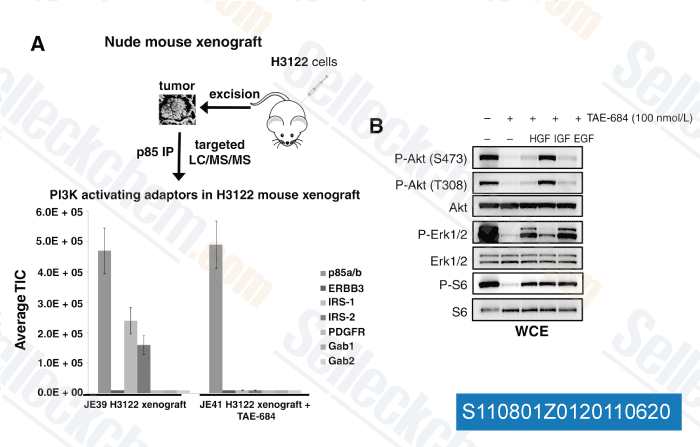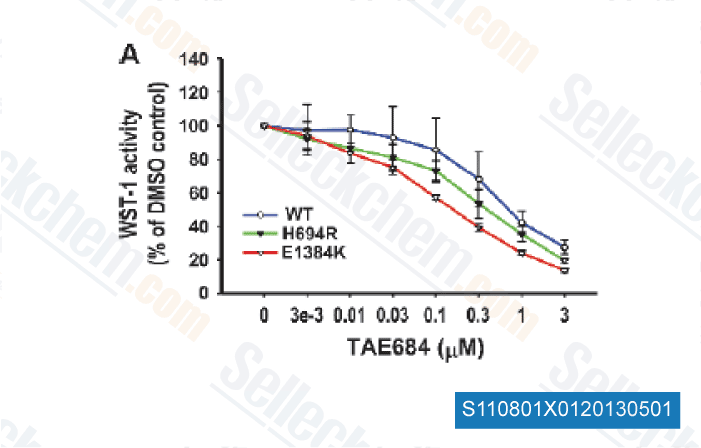|
Toll Free: (877) 796-6397 -- USA and Canada only -- |
Fax: +1-832-582-8590 Orders: +1-832-582-8158 |
Tech Support: +1-832-582-8158 Ext:3 Please provide your Order Number in the email. |
Technical Data
| Formula | C30H40ClN7O3S |
|||
| Molecular Weight | 614.2 | CAS No. | 761439-42-3 | |
| Solubility (25°C)* | In vitro | DMSO | 30 mg/mL (48.84 mM) | |
| Ethanol | 2 mg/mL (3.25 mM) | |||
| Water | Insoluble | |||
|
* <1 mg/ml means slightly soluble or insoluble. * Please note that Selleck tests the solubility of all compounds in-house, and the actual solubility may differ slightly from published values. This is normal and is due to slight batch-to-batch variations. * Room temperature shipping (Stability testing shows this product can be shipped without any cooling measures.) |
||||
Preparing Stock Solutions
Biological Activity
| Description | TAE684 (NVP-TAE684) is a potent and selective ALK inhibitor which blocked the growth of ALCL-derived and ALK-dependent cell lines with IC50 values between 2 and 10 nM, 100-fold more sensitive for ALK than InsR. TAE684 (NVP-TAE684) induces cell cycle arrest and apoptosis. | ||
|---|---|---|---|
| Targets |
|
||
| In vitro | TAE684 does not exhibit significant cross-reactivity against other kinases. TAE684 potently inhibits the proliferation of Ba/F3 NPM-ALK cells with IC50 of 3 nM, without affecting the survival of Ba/F3 cells even at 1 μM. TAE684 also inhibits proliferation of NPM-ALK-expressing human ALCL cell lines including Karpas-299 and SU-DHL-1 with IC50 of 2–5 nM. Molecular modeling reveals that L258 may be one of the major kinase-selectivity determinants for TAE684. TAE684 treatment results in a rapid and sustained inhibition of phosphorylation of NPM-ALK. TAE684 induces apoptosis and G1 phase arrest in NPM-ALK-expressing Ba/F3 cells and ALCL patient cell lines. [1] TAE684 markedly overcomes resistance in H3122 CR cells, harboring the fusion oncogene EML4-ALK, decreasing cell growth, suppressing ALK phosphorylation and inducing apoptosis.[2] Neurite outgrowth induced by expression of the mALK R1279Q mutant could be completely inhibited by TAE684 at 30 nM. [3] |
||
| In vivo | After 4 weeks of treatment with TAE684 at 3 and 10 mg/kg, there is a significant delay in lymphoma development and 100- to 1,000-fold reduction in luminescence signal, without any signs of compound- or disease-related toxicity in Karpas-299 lymphoma model. TAE684 treatment also induces disease regression in established Karpas-299 lymphomas and down-regulates CD30 expression. [1] TAE684 also shows impressive antitumor activity against H3122 CR xenograft tumors. [2] Furthermore, treatment with TAE684 improves the rough eye phenotype of both ALK mutants, especially that seen with ALKR1275Q. [3] |
Protocol (from reference)
| Kinase Assay: |
|
|---|---|
| Cell Assay: |
|
| Animal Study: |
|
References
Customer Product Validation

-
Data from [Cancer Res, 2011, 71, 4920-31]

-
Data from [Neoplasia, 2011, 13, 704-15]

-
Data from [Neoplasia, 2011, 13, 704-15]

-
Data from [Neoplasia, 2011, 13, 704-15]
Selleck's TAE684 (NVP-TAE684) has been cited by 88 publications
| Selective impact of ALK and MELK inhibition on ERα stability and cell proliferation in cell lines representing distinct molecular phenotypes of breast cancer [ Sci Rep, 2024, 14(1):8200] | PubMed: 38589728 |
| LTK and ALK promote neuronal polarity and cortical migration by inhibiting IGF1R activity [ EMBO Rep, 2023, 24(7):e56937] | PubMed: 37291945 |
| Development of the nonreceptor tyrosine kinase FER-targeting PROTACs as a potential strategy for antagonizing ovarian cancer cell motility and invasiveness [ J Biol Chem, 2023, 299(6):104825] | PubMed: 37196766 |
| Autocrine EGF and TGF-α promote primary and acquired resistance to ALK/c-Met kinase inhibitors in non-small-cell lung cancer [ Pharmacol Res Perspect, 2023, 11(1):e01047] | PubMed: 36583451 |
| Selective Impact of ALK and MELK Inhibition on ERα Stability and Cell Proliferation in Cell Lines Representing Distinct Molecular Phenotypes of Breast Cancer [ bioRxiv, 2023, 10.1101/2023.12.19.572304] | PubMed: none |
| Integrative analysis of drug response and clinical outcome in acute myeloid leukemia [ Cancer Cell, 2022, S1535-6108(22)00312-9] | PubMed: 35868306 |
| Deregulation and epigenetic modification of BCL2-family genes cause resistance to venetoclax in hematologic malignancies [ Blood, 2022, blood.2021014304] | PubMed: 35704690 |
| Prediction of drug candidates for clear cell renal cell carcinoma using a systems biology-based drug repositioning approach [ EBioMedicine, 2022, 78:103963] | PubMed: 35339898 |
| FER-mediated phosphorylation and PIK3R2 recruitment on IRS4 promotes AKT activation and tumorigenesis in ovarian cancer cells [ Elife, 2022, 11e76183] | PubMed: 35550247 |
| Comprehensive drug response profiling and pan-omic analysis identified therapeutic candidates and prognostic biomarkers for Asian cholangiocarcinoma [ iScience, 2022, 25(10):105182] | PubMed: 36248745 |
RETURN POLICY
Selleck Chemical’s Unconditional Return Policy ensures a smooth online shopping experience for our customers. If you are in any way unsatisfied with your purchase, you may return any item(s) within 7 days of receiving it. In the event of product quality issues, either protocol related or product related problems, you may return any item(s) within 365 days from the original purchase date. Please follow the instructions below when returning products.
SHIPPING AND STORAGE
Selleck products are transported at room temperature. If you receive the product at room temperature, please rest assured, the Selleck Quality Inspection Department has conducted experiments to verify that the normal temperature placement of one month will not affect the biological activity of powder products. After collecting, please store the product according to the requirements described in the datasheet. Most Selleck products are stable under the recommended conditions.
NOT FOR HUMAN, VETERINARY DIAGNOSTIC OR THERAPEUTIC USE.
